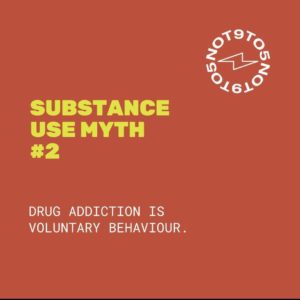Substance Use Myth #2: Addiction is a voluntary behaviour
Writer: Lisa Quigley
We like to believe that substance use disorder (SUD) is a character flaw because it is easier to blame someone for their own failure of will than acknowledge it as the complex, chronic disease that it is. Similar to how mental illness is mistakenly viewed as an individual problem, substance use challenges are as well. Addiction can be attributed to the interaction of numerous biological, behavioural and social components in a person’s life [1]https://ontario.cmha.ca/factors-that-impact-addiction-and-substance-misuse/. They result in changes to behaviours, personality, memory processes and moods, making it seem like the person struggling is a ‘bad’ person, but the reality is that they need support, connection and continued care, much like other chronic illnesses .
As a society, we demonize those suffering from addiction. It is commonly judged as a lack of willpower or a personal choice, so the person is filled with shame and guilt, making it that much harder for them to confide in a friend or reach out for professional support. It is this individualization of addiction that fuels the stigma around it, which is just as damaging as the act of harmful substance use itself. Judgment towards a person experiencing addiction only perpetuates the cycle of addictive patterns and behaviours.
The terms ‘substance use disorder (SUD)’ and ‘addiction’ are mostly used interchangeably to describe the illness, as it is integral to encompass the spectrum that it is and move away from binary and stigmatizing terms such as calling someone ‘an addict’ or ‘sober.’ Labels are problematic as they assume the entirety of someone’s identity and deny the possibility for a change in state. A harm reduction approach emphasizes a person’s right to make personal choices and define recovery and wellness for themselves.
In part, addiction is not accepted as a chronic disease because of the initial voluntary act of using a substance, but this can be compared with diseases such as diabetes and hypertension, which have initial voluntary actions as well [2]https://www.ncbi.nlm.nih.gov/pubmed/11015800. When we compare factors such as genetic heritability and personal responsibility, we see that addiction, hypertension and diabetes are all equally influenced and affected by initiation and levels of maintenance [3]https://archives.drugabuse.gov/publications/drug-abuse-addiction-one-americas-most-challenging-public-health-problems. For example, a person that routinely consumes salt whilst knowing they have a genetic predisposition to hypertension compared to a person that routinely consumes alcohol even though they are well aware that they have a genetic predisposition to addictive tendencies.
Much like hypertension and diabetes, there is no cure for addiction. An individual’s success relies heavily on their compliance to the medical and counseling regimen specific to their needs [4]https://archives.drugabuse.gov/publications/drug-abuse-addiction-one-americas-most-challenging-public-health-problems. It is important to note here that there is no blanket-fix or singular path to recovery.
Recovery looks and means something different for everyone, and it is key to support your loved ones whichever methods and approach they choose. The percentage of treatment adherence in people with diabetes and hypertension are comparable with those of addiction (40-60%). Yet still, addiction treatment is designed as a self- contained, acute episode of care comparable with that of a bacterial infection [5]https://doi.org/10.1300/J020v20n03_06, while the chronic diseases listed receive long-term care, even with the high rates of relapse and need for additional medical attention for symptom remission [6]https://www.ncbi.nlm.nih.gov/pubmed/11015800.
Addictive drugs affect the brain regions and neurotransmitters responsible for the control of motivated and learned behaviours [7]http://dx.doi.org/10.1016/j.pharmthera.2013.12.012. Many neurotransmitters are affected by the use of drugs, including but not limited to GABA, glutamate, serotonin and dopamine. Dopamine is responsible for reward and salience, which refers to environmental changes that arouse anticipation for reward and facilitates conditioned learning, which may help to explain how one’s environment increases the likelihood of relapse [8]http://dx.doi.org/10.1146/annurev-pharmtox-010611-134625. Repeated use of a drug causes a significant reduction in one’s natural ability to produce dopamine, and their ability to anticipate delayed rewards, meaning the person needs the shortcut that substances provide to achieve high dopamine levels [9]http://www.health.harvard.edu/mind-and-mood/the_addicted_brain.
A study done on activation in prefrontal regions from exposure to a stimulant drug shows increased activity in the brain of a person struggling with addiction, while none occurs in those who do not, suggesting this stimulation is specific to the brain of someone with SUD [10]http://dx.doi.org/10.1146/annurev-pharmtox-010611-134625. The modification of brain chemicals in the prefrontal cortex (motivation and compulsive behaviour), the dorsal striatum (habit forming learning), amygdala and hippocampus (memory and learning) and nucleus accumbens (reward) has lasting, and potentially permanent effects on cognition, motivation and behaviour [11]http://dx.doi.org/10.1016/j.pharmthera.2013.12.012 [12]10.1146/annurev-pharmtox-010611-134625.
With the acceptance of addiction as a chronic disease rather than an acute illness, the perception of addiction as an individual issue and personal failure is vastly reduced. Instead of having the idealized view that the only success in addiction treatment is complete abstinence, treatment should be based on more achievable goals. This helps a person struggling with SUD to feel confident in their own abilities to get better instead of feeling defeated after one attempt to quit, which may result in more harmful substance use than before.
Relapse is a very normal aspect of the healing journey. Every individual responds to treatment differently and it is important they know that there are different options available for them if the first doesn’t work; it is equally important for them to know that health professionals and their loved ones will not give up on them in this scenario. Every person deserves to be treated with compassion and dignity.
If you are struggling with substance use and want to reach out for support, visit our resources page Substance Use Support.
ID: Substance use myth #2 written in yellow text on an orange background. Drug addiction is voluntary behavior in white text underneath Substance use myth #2, with a white Not 9 to 5 logo in the top right corner.
References




